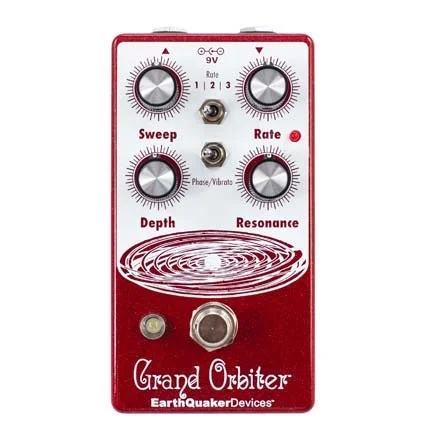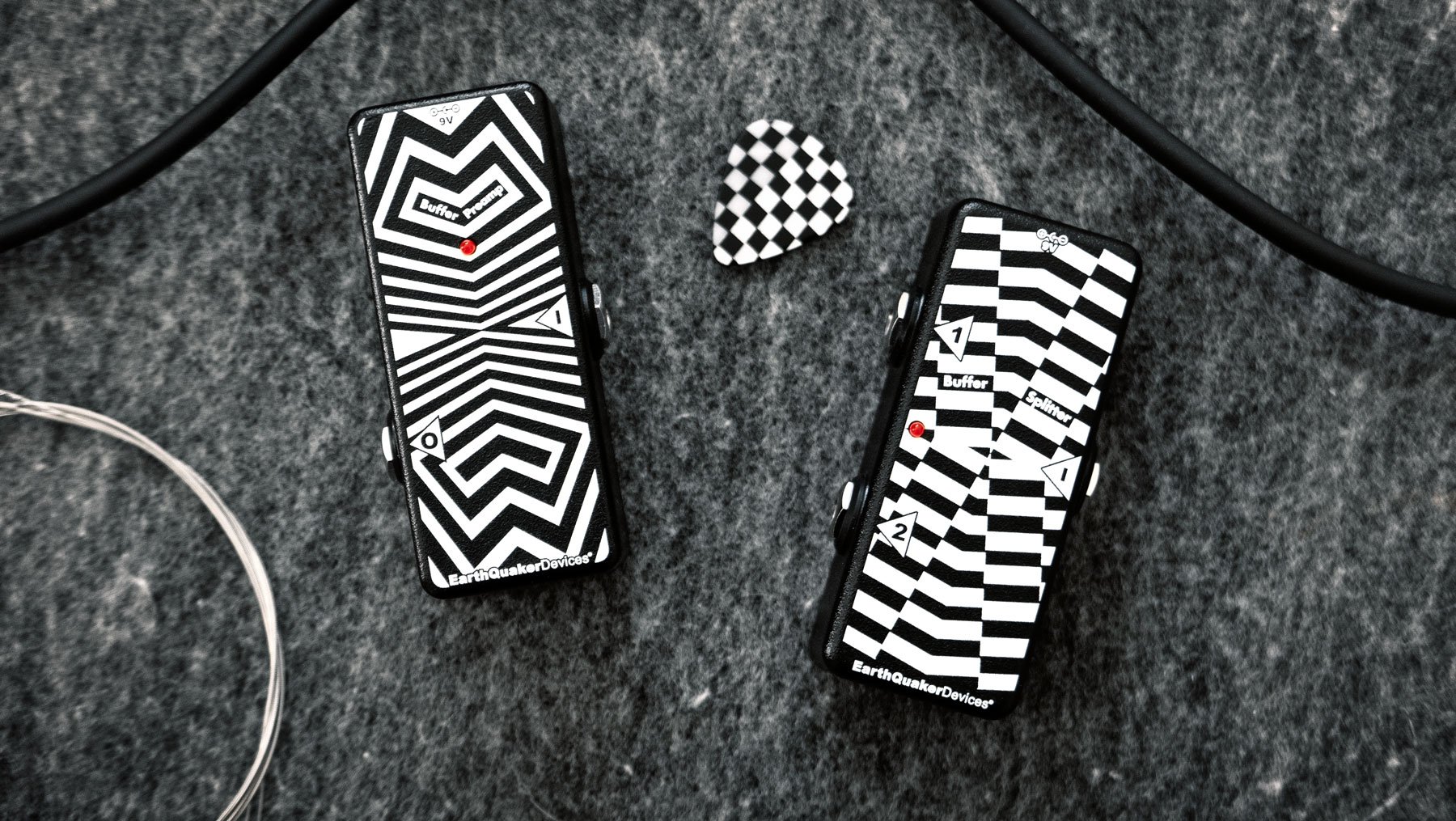5 Reasons Everyone Needs a Phaser
Dan Epstein
I may as well come right out and admit it: for the longest time, I was a phaser denier. I played guitar in bands for years — decades, even — before it ever occurred to me that a phaser was something that belonged on my pedal board.
In retrospect, part of the issue was that I always liked to keep my stompbox selection as lean n’ mean as possible. A wah, a fuzz or distortion, and an EQ pedal for boosting my solos were usually all I ever took to gigs or recording sessions, though I’d occasionally throw a compressor or a chorus into my pedal chain if the situation called for a little jangling. Phasers, like flangers or delays, just seemed too damn fussy for my purposes; in my mind; those were for shred-meisters and other ‘80s-damaged guitarists who didn’t mind drowning their natural guitar and amp tones in a roiling sea of signal processing. As a straight-ahead rocker with garage/psych tendencies, I wanted my SGs and Teles to sound like SGs and Teles, regardless of whatever amps they were plugged into, and I figured a phaser would just get in the way of all that.
The other problem was that, well, I didn’t actually understand what it was that a phaser pedal did. This was largely because I associated the term “phasing” with the psychedelic whooshing effects I’d heard on such ‘60s classics as The Small Faces’ “Itchycoo Park” and The Jimi Hendrix Experience’s “Bold As Love.” While I dearly loved those tracks, and the dramatic way that they were punctuated by the effect, “phasing” (at least as I understood it) seemed about as dated to me as a tie-dye shirt; plus, it seemed to me more like a fun production tool than a guitar effect. I wouldn’t run a drum set through a Big Muff, so why would I run my guitar through a phaser?
Of course, I eventually learned that what I’d mistaken for phasing on those records was actually tape flanging — a close cousin of phasing, if you will, but an effect that’s achieved in a different way. Basically, flanging (whether via tape or a pedal) mixes a dry signal with a delayed one, then feeds the delayed signal back into the signal chain to create harmonic feedback. Phasing, on the other hand, mixes two identical signals together. One remains dry, while the other is sent through a series of all-pass filters (also known as “stages”) whose position can changed by adjusting the speed of a Low Frequency Oscillator (also known as an “LFO”), thus causing the frequency spectrums of the two signals to match, unmatch, and match again to produce the classic swirling phaser effect.
But it wasn’t this sort of technical mumbo-jumbo that convinced me to add a phaser to my pedal chain — rather it was the slowly-dawning realization that some of my favorite guitarists from a variety of genres had employed the effect to achieve a wide array of sonic results, ranging from subtle to completely bonkers.
There are a lot of phasers out there on to choose from, which run the gamut from the simplicity of the classic single-knob MXR Phase 90 to highly complex ones big enough to eat a sandwich off of, and the number of stages varies drastically from model to model. I’ve been digging the EarthQuaker Grand Orbiter lately, both because its 4-stage analog circuit delivers a seriously vintage vibe, and its four control knobs (plus its three-position Rate switch) allow me a wide variety of sonic options without sending me so far down the rabbit hole that I spend more time twiddling than playing. But whichever one you choose, here are five things you can do with a phaser — i.e., five good reasons you should definitely have one in your sonic arsenal…
GET HEAVY
One of the most useful things about phasers is the thick textures that they can add to your tone. When the LFO (controlled by the “Rate” knob on the Grand Orbiter) is set at a lower speed, this additional beef can be very subtle, where you’re almost feeling it more than hearing it; but when you crank up the LFO and add some distortion (either from the amp or a dirt pedal) to the proceedings, the results can be as sludgy, zesty and deliciously messy as a pot of all-day chili. This quality can be especially advantageous if you’re the lone guitarist in a heavy, hard-rocking band. Eddie Van Halen relied heavily on a MXR Phase 90 to create his patented “brown sound,” adding texture and weight to his riffs (the first two VH albums are literally dripping with phase). But the phaser also helped his solos “pop” a little more during live gigs in his band’s early days, when he often had to contend with shoddy club P.A.s and inattentive soundmen. Brian May regularly employed Foxx Phasers for Queen’s live gigs; and while most folks wouldn’t classify the Sex Pistols as a “heavy” band, there’s no question that Steve Jones’ guitar tones on Never Mind the Bollocks were heavy as hell, or that a Phase 90 played a big role in making them that way.
GET FUNKY
That aforementioned thickening effect can also be incredibly helpful if you’re playing funk, especially if you’re using single-coil pickups, like in a Stratocaster or a Telecaster. Try strumming a clean, choppy, up-the-neck chord pattern a la Chic’s Nile Rodgers without any effects on it; then try it again with a touch of phaser on it — even at more subtle settings, the pedal can add enough heft and gleam to the chords to really shine through the mix, even against a hard-grooving rhythm section. Carlos Alomar, David Bowie’s funky right-hand man, used both a Mu-Tron Bi-Phase and an Electro-Harmonix Small Stone to emphasize his rhythm licks on Bowie’s mid/late-‘70s records. And of course, Ernie Isley combined a Maestro Phase Shifter with an Electro-Harmonix Big Muff to create perhaps the most oft-imitated ‘70s funk lead tone of all time — that sweetly zippery “That Lady” sound.
GET VIBE-Y
Back in the mid/late 1960s, recording artists and producers discovered that they could achieve fabulously disorienting (and extremely psychedelic) effects by running vocals or guitars through Leslie rotating speakers, which had originally been built for use with organs. Of course, dragging around a 140-pound cabinet wasn’t really an option for most guitarists, so Japanese engineer Fumio Mieda created what we now know as the Uni-Vibe in an attempt to provide a cheaper and more compact way to recreate the Leslie’s woozy, watery sound. Jimi Hendrix, David Gilmour and Robin Trower were three of the most the most prominent early Uni-Vibe adherents; the effect can be heard all over Hendrix’s “Machine Gun,” Pink Floyd’s “Breathe” and Trower’s “Bridge of Sighs.” And while the original Uni-Vibe had more bells and whistles than most contemporary phasers, the effect’s circuit is basically that of a 4-stage phaser, which means it’s pretty easy to dial a convincing Uni-Vibe sound with a phaser (like, say, the Grand Orbiter) that features additional control knobs that allow you to shape the intensity of your signal and adjust the level of its frequency peaks.
GET DREAMY
One of the phaser’s greatest attributes is the way it can add texture and flavor to a basic chord progression, especially one that’s strummed relatively slowly with open chords and ringing strings. Try playing a C-shape chord up and down the neck with a phaser engaged, and marvel at how majestic, wistful and/or dreamy such a simple thing can sound through the pedal at its slower settings. If enchanting atmospherics are what you’re after, just add some reverb to your phased signal — or, if you already have a delay pedal, put the phaser in that effect’s feedback loop to process the repeats. Tame Impala’s Kevin Parker is a master of conjuring up trippy soundscapes, and the phaser (in his case, a Small Stone) is an absolutely key part of his sound. “Life is better with phaser pedals,” he told an interviewer in 2011. “If I could put my breakfast through a phaser pedal, I promise you I would.”
GET CRAZY
Finding just the right phaser settings for your song or sound can be a matter of painstaking trial and error, especially with pedals that have more than just an LFO rate control. But you can also take the opposite of the fine-tuning approach, and just crank every available knob to see what happens — because if you’re into jarring, disturbing and decidedly abrasive sounds, a phaser can definitely deliver those, as well. Just ask Opeth mainman Mikael Åkerfeldt, who in 2017 praised the Grand Orbiter as “a phaser with a shitload of sounds within it,” adding, “At the moment, I only use it for isolated chords to get this underwater effect that makes you sick to your stomach!”
Dan Epstein is an author, editor, journalist and guitarist based in New York's Hudson Valley. He writes about his latest musical obsessions at Jagged Time Lapse, and songs from his latest musical project The Corinthian Columns can be found at corinthiancolumns.bandcamp.com






